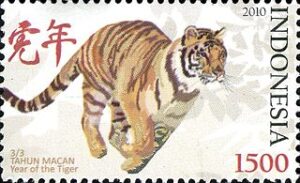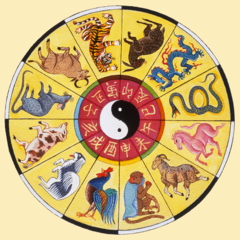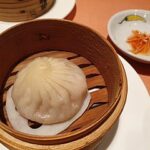
The Year of the Tiger begins tomorrow, February 1st , but celebrations for the Lunar New Year take place from January 31st through February 15th.
New Year —New Luck
Prior to the first day of the new year, people deep clean their homes to remove huiqi [inauspicious breaths] and to appease the gods who will inspect the home. The first day of the new year is not a time to sweep the house, lest you sweep out good luck, or wash either your hair or your clothing, which will also wash out good fortune.
The Great Race

According to legend, there was once a Great Race among the animals to see who could reach the Jade Emperor first. The first twelve animals to complete the race received a year in the 12-year lunar cycle.
The Ox would have been first if she hadn’t been tricked by the Rat who hitched a ride on her back, and then jumped off so he arrived ahead of the Ox. This explains why the Rat is first animal in the cycle and the Ox, second. The other ten animals are the Tiger, Rabbit, Dragon, Snake, Horse, Goat, Monkey, Rooster, Dog, and Pig. It is said the pig came in last, because he stopped for a snack.

A person is assigned the attributes of the animal in control the year he or she is born and these animals reflect how a person is seen by other people and how she sees herself.
Someone born in a Tiger year is said to be brave, competitive, unpredictable, confident, charming, well-liked, and stubborn. All of these are useful attributes, except in the year of the Tiger.
During a Tiger year, people born in the year of the Rabbit, Dragon, Horse, or Rooster will have an easy year and good luck with their finances. Those born in Rat, Snake, Monkey, Dog, or Pig years can still have good fortune, but will have to work harder for it. Tiger people need to be careful this year and keep a low profile. They will have better prospects next year.
Special Foods

Traditionally, New Year celebrations are a time when families enjoy special foods.

CHANG SHOU MIAN [Longevity Noodles] are eaten during the first five days of the celebration to encourage long life. The noodles are not cut, and are supposed to be eaten with one long slurp rather than chewing.
SPRING ROLLS are shaped like gold bars to symbolize wealth.


NIAN GAO [Rice Cakes] symbolizes the hope that every year will be better than the last, because the word GAO is pronounced the same way as the word for tall or high.
TANGYUAN [Sweet Rice Balls] are round to encourage family togetherness.

STEAMED WHOLE FISH is the last item to be eaten at the meal. The word for fish is pronounced YU, which sounds the same word for surplus. The fish symbolizes wealth and prosperity and is served with the head and tail intact.

JIAO ZI [Dumplings] are shared on the 15th and final day of the celebrations as a sign of the family unit. The dumplings ae shaped like gold ingots, so the more dumplings you eat, the more wealth you will have. The word jiao zi has two other meanings. It was the name of the first form of paper money, and also refers to the hour just before the new year as a time of transition between old and new. Sometimes a coin is placed one of the dumplings for extra good luck.
I think of the Lunar New Year celebrations as the last of the holidays that began in December. May the year ahead bring you good health and prosperity.
🐅 🐅 🐅
Illustrations
Indonesian Stamp, 2010 Year of Tiger.
Chinese Zodiac by RootOfAllLight.
Tiger by S. Taheri, edited by Fir0002.
Longevity/birthday noodles by N509FZ.
Spring rolls by Hiroooooo.
Imprinted black sesame rice cake by DragonSamYU.
Glutinous Rice Balls by BYTE RIDER.
Steamed whole fish by KM Francois George Pierre.
Dumpling by Macgills2.
Alex Nelson. “Chinese Zodiac Signs.” National World. Jan. 25, 2022.
Xenia Fong. “All the Lunar New Year Dishes.” Food Network.

Sandra Wagner-Wright holds the doctoral degree in history and taught women’s and global history at the University of Hawai`i. Sandra travels for her research, most recently to Salem, Massachusetts, the setting of her new Salem Stories series. She also enjoys traveling for new experiences. Recent trips include Antarctica and a river cruise on the Rhine from Amsterdam to Basel.
Sandra particularly likes writing about strong women who make a difference. She lives in Hilo, Hawai`i with her family and writes a blog relating to history, travel, and the idiosyncrasies of life.


Great read again!
Thank you. I’m so glad you found it interesting.